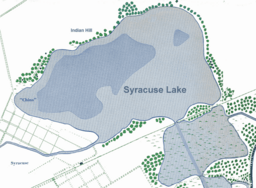Syracuse Lake facts for kids
Quick facts for kids Syracuse Lake |
|
|---|---|

1910 map of Syracuse Lake
|
|
| Location | Kosciusko County, Indiana, United States |
| Coordinates | 41°25′36″N 85°44′13″W / 41.4266°N 85.7369°W |
| Basin countries | United States |
| Surface area | 1.67 km2 (414 acres) |
| Average depth | 3.9 m (13 ft) |
| Max. depth | 10 m (34 ft) |
Syracuse Lake is a natural lake bordering Syracuse in Kosciusko County, Indiana, United States.
Contents
Location
Lake Syracuse is bordered on the west by N. Front Street, Pickwick Road and the B&O Railroad on the south. On the east it is bordered by E. Shore Drive and on the north by E. Northshore Drive. It connects to Lake Wawasee by a channel on the south end.
Hydrology
Syracuse Lake is classified as a Trophic Class 1 lake having eutrophication index value of 10.
The lake is typical in structure of natural lakes of the glaciated portions of the upper Midwest. The lake is presently healthy and has balanced aquatic ecosystem (WAW 1995). It has a surface area of 1.67 km2 (414 acres) with a maximum depth of 10 m (34 ft) and an average depth of 3.9 m (13 ft).
History
Pre-glaciation
Around 1 million years ago, just prior to the Pleistocene epoch, northern Indiana was covered by the Teays River system, which flowed northwest out of Virginia, West Virginia, and Ohio, entering Indiana at Adams County and flowing about 49 miles south of what is now Syracuse Lake.
Post-glaciation
After the last glaciation period, the land was left with kettle holes and hilly moraines. The land supported large vast Picea evergreen forests, and balsam poplar, which gave way to hardwoods of oak and hickory. Animal life consisted of Glyptodon, saber-toothed cat, mastodon, short-faced bear, dire wolf, ground sloth, giant beaver, peccary, stag-moose and ancient bison. Lakes would have sturgeon, whitefish, pike, pickerel, and muskellunge.
Human inhabitation
The ground around Syracuse Lake and Syracuse was first settled by the people of the Glacial Kame Culture who would leave behind artifacts and burial sites.
The Syracuse dugout
In 1959 Dick Jamison of Syracuse was fishing in 4 feet (1.2 m) or 5 feet (1.5 m) of water just off the southeast shore. He saw a wobbling image underwater of what he thought was a large water-soaked log with one end protruding from the green algae moss. The object had an unusual flat and sharp end and was hollowed out just back of the visible end. He and his father returned and removed moss, marl, and slime exposing a blackened dugout canoe made of a tulip tree measuring 21 feet (6.4 m) and between 3–4 feet (91–121 cm) wide. Age and exposure had rotted away most of the sides. It was thought that it belonged to Miami Indians or fur traders, or by very early settlers and that the canoe had been abandoned on the old shore of the lake prior to raising of the lake by the dam built in 1834.
Indian Hill
Indian Hill is located on the north shore of Syracuse Lake 1.5 miles to the east of the town of Syracuse. It was a cemetery for the Indians of the area, who interred their dead in trees. Eventually the wrapping around the dead would disintegrate, causing the skeletal remains to fall to the ground.
Accounts of sturgeon
In 1912 a Bing Raymond caught a 32-inch (810 mm) sturgeon in Lake Syracuse off the lake's extreme northwest side, near a place called China. Yet another sturgeon was seen about the same year by four men in the lake. The third account occurred in the 1920s when a Charlotte White discovered a disabled sturgeon measuring 7 feet (2.1 m), 3 inches and weighing 130 lb suffocated by a pair of waterwings caught in its gills.
Current population
Syracuse, like its neighbor, Lake Wawasee, is lined with many homes used seasonally and by those who live there year-round.
Resources
- Lilly, Eli. Early Wawasee Days. Indianapolis: Studio Press Inc., 1960.



